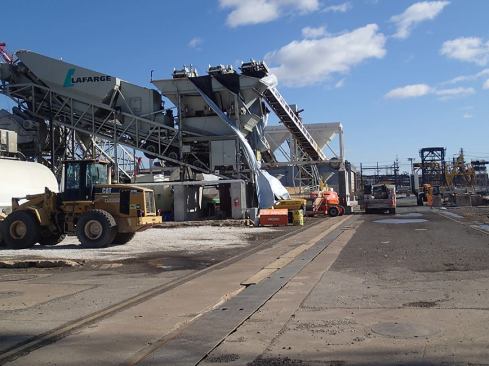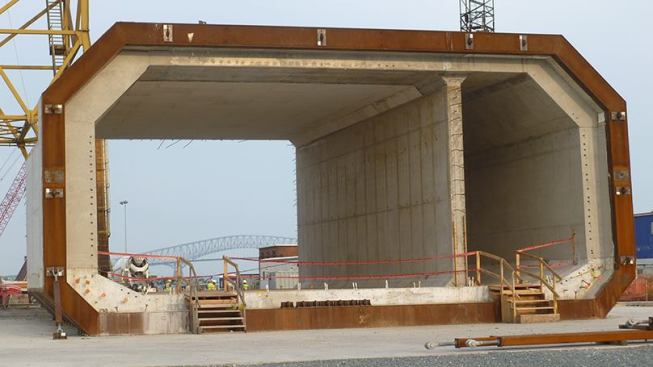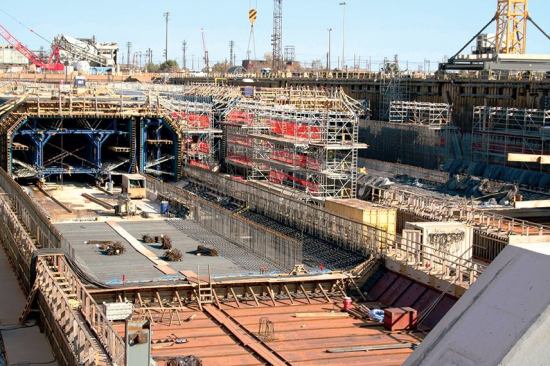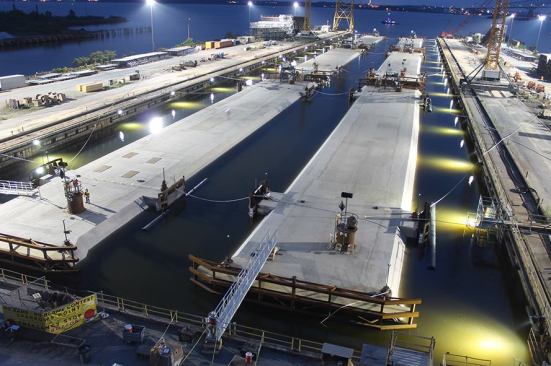The Elizabeth River Tunnels Project
To ensure a high degree of consistency, reliability, and quality…
Quality control at the forefront
To ensure a high degree of consistency, reliability, and quality, the project team mobilized two concrete batch plants. At the fabrication site, the two portable Lafarge plants produced 72,000 cubic yards of SCC, testing every load for air content, unit weight, slump, and temperature.
Lafarge kept its Sparrows Point slag cement processing facility and other operations open whenever the materials were needed, which was important because the structural concrete placements during the summer typically started at midnight. Following strict quality control guidelines and sometimes working around the clock, Lafarge’s cement and aggregate production teams, along with the company’s local crew of more than 50 delivery drivers, supplied the slag cement and aggregate for the concrete mix.
Keeping it cool
Due to the high ambient temperatures during the summer (up to 96° F) and the concern for the temperature rise that occurs during concrete curing, the mix was injected with liquid nitrogen to cool the concrete to a temperature between 60° F and 70° F before it was placed. SKW also installed a heating and cooling system throughout the invert, walls, and roof of each segment, and pumped a glycol coolant solution through the hoses during curing to help control the concrete temperatures. Thermocouples were used in all pours in conjunction with a maturity system to monitor temperature data and predict concrete strengths for form removal timing.
The first production pour of element 1/segment 1 in April 2013 went smoothly. After three days, the formwork was stripped and rolled ahead on the rail into position for the next pour. All 11 segments of the massive tunnel elements are now complete.
Float-out and immersion
The first six massive tunnel elements (litter 1) arrived at the Portsmouth Marine Terminal in summer 2014, after being towed one at a time by a tug fleet down the Chesapeake Bay. In March 2015, the new Midtown Tunnel reached the halfway mark with the immersion of the sixth tunnel element and its connection to the five previously placed elements.
At the same time, the remaining five concrete tunnel elements (litter 2) were completed at the Sparrows Point fabrication dry docks and prepared for float-out to the Virginia jobsite. This preparation process included sealing and waterproofing the elements, constructing four temporary, interior ballast tanks in each to provide stability during floating and towing, and installing temporary bulkheads on each end to allow the elements to float. For the voyage, each tunnel section was outfitted with entry hatches, navigational lights, GPS survey towers, and fenders to protect against any wayward debris. The second litter of Elements 7 to 11 reached Portsmouth in April, and the elements were placed across the Elizabeth River at the rate of about one every five weeks. The last tunnel element was immersed on July 14, 2015, connecting the shorlines of Portsmouth and Norfolk.
Broad and lasting benefits
The new Midtown Tunnel will offer broad and lasting benefits to the Hampton Roads transportation system, its economy, and the lives of those who live and work in the region. When the tunnel is completed in 2016, the existing 54-year-old tunnel will be rehabbed, after which the side-by-side tunnels will carry two lanes of traffic in each direction. The average round-trip user will save about 30 minutes a day, roadway safety will improve with the elimination of bidirectional traffic, and increased capacity will support the movement of goods in and out of various port facilities in the region.
Kirk Deadrick is director of quality, Ready Mix U.S. at Lafarge North America. For more information, visit www.lafarge-na.com.









